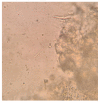Mucorales/ Fusarium Mixed Infection in Hematologic Patient with COVID-19 Complications: An Unfortunate Combination
- PMID: 36839576
- PMCID: PMC9964160
- DOI: 10.3390/pathogens12020304
Mucorales/ Fusarium Mixed Infection in Hematologic Patient with COVID-19 Complications: An Unfortunate Combination
Abstract
Hematological diseases, especially those causing severe neutropenia, represent the main factor in the development of invasive fungal infections (IFIs). Furthermore, COVID-19 has been considerably associated with IFIs due to immunological dysregulation, prolonged hospitalization in intensive care units, and immunomodulatory therapies. Opportunistic molds are correlated with elevated morbidity and mortality rates in these patients, due to immune impairment, diagnostic complexity, and therapeutic challenges. Among opportunistic fungal infections, the Mucorales and Fusarium species are considered particularly aggressive, especially during severe neutropenia. A mixed Mucorales/Fusarium infection has been rarely described in scientific literature. Herein, we report a case of Mucorales and Fusarium co-infection in a patient with acute leukemia whose clinical history was also complicated by COVID-19. Herein, we report a challenging case in order to encourage the clinical suspicion of combined fungal infections in immunosuppressed patients, performing a punctual microbiological diagnosis, and promptly administering the correct empiric and targeted antifungal therapy.
Keywords: Fusarium infections; Fusarium/Mucorales infections; antifungal stewardship; invasive fungal infections.
Conflict of interest statement
The authors declare no conflict of interest.
Figures





References
-
- Ceccarelli M., Marino A., Pulvirenti S., Coco V., Busà B., Nunnari G., Cacopardo B.S. Bacterial and Fungal Co-Infections and Superinfections in a Cohort of COVID-19 Patients: Real-Life Data from an Italian Third Level Hospital. Infect. Dis. Rep. 2022;14:372–382. doi: 10.3390/idr14030041. - DOI - PMC - PubMed
-
- Durand-Joly I., Alfandari S., Benchikh Z., Rodrigue M., Espinel-Ingroff A., Catteau B., Cordevant C., Camus D., Dei-Cas E., Bauters F., et al. Successful outcome of disseminated Fusarium infection with skin localization treated with voriconazole and amphotericin B-lipid complex in a patient with acute leukemia. J. Clin. Microbiol. 2003;41:4898–4900. doi: 10.1128/JCM.41.10.4898-4900.2003. - DOI - PMC - PubMed
Publication types
LinkOut - more resources
Full Text Sources

